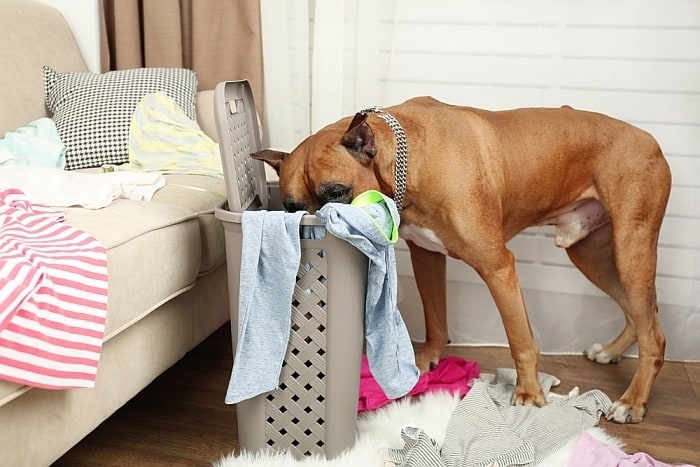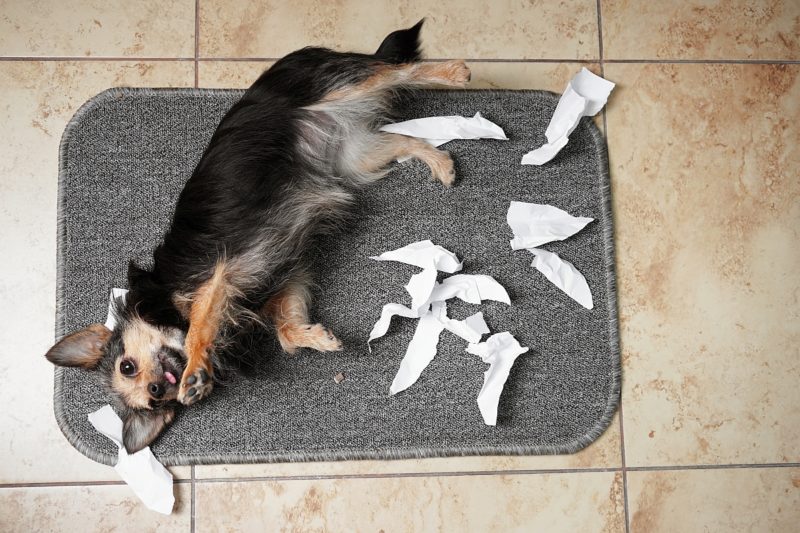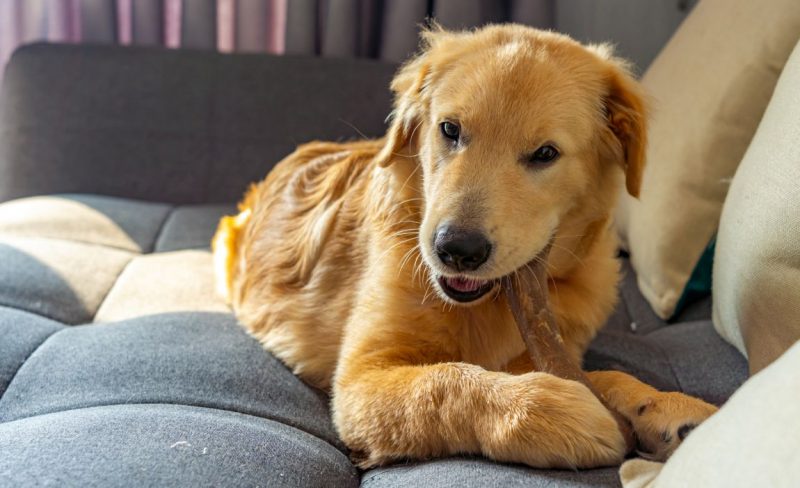You don’t have to be a dog owner for long before you realize that your pet may eat just about anything you leave lying around.
They may rummage through the bathroom to find something fun to devour. Some dogs even eat stinging insects. But, while eating inedible (or barely edible) items is pretty common behavior in dogs, it can also cause serious problems.
For example, if your dog consumes an article of clothing – and socks seem to be one of their favorite garments – she could experience very serious complications, which may threaten her very life. Get to the vet immediately if you’ve just discovered that your dryer isn’t the only thing in your home that eats socks.
In the meantime, we’ll explain the likely ramifications of your dog’s indiscretion and help you understand what to expect at the vet.
Problems Caused by a Swallowed Sock
Socks may seem relatively benign, but they can actually wreak considerable havoc while traveling through your dog’s digestive tract. They’ll occasionally pass through a dog’s digestive system without much trouble, but it is always a situation to take seriously.
Socks – like most other fabrics or garments – will absorb moisture while in your dog’s body. This can cause the sock to swell up and become stuck.
This type of obstruction can prevent the normal passage of food and water through your pet’s system, resulting in symptoms like nausea, vomiting, anorexia, and diarrhea, among others.
If the sock isn’t removed quickly, it can press against the sides of the intestines, cutting off the flow of blood. This can cause the intestinal tissue to die, a potentially life-threatening condition which can necessitate expensive and invasive surgery to repair.
Socks can also scrape the inside surfaces of your dog’s intestines, which can lead to ulcers or perforations. This is particularly likely when the threads of the sock unravel. As the threads stretch out, they can be repeatedly pulled in opposite directions by the involuntary contractions of the intestinal tract. This type of repeated back-and-forth motion may rip your dog’s insides to shreds.
Choking is also a serious concern. A wet, swollen sock can block your dog’s windpipe, which will make it difficult for your dog to breathe and likely trigger quite a bit of panic.
Veterinary Strategies and Treatments
Upon arriving at the vet’s office, the staff will assess your pooch’s vitals and take a history.
They will ask several questions about the incident, your dog’s general health, and, of course, the sock. For example, a thick wool sock may require different treatment strategies than a cotton tennis sock would.
Your vet will then move on to a physical examination, including a visual inspection of the mouth and throat. He or she will also palpate your dog’s abdomen to check for rigidity or pain.
X-rays will usually be ordered to help determine the location of the sock, although it may be possible to see the sock with an endoscope – a long, flexible camera your vet can slip down your dog’s throat – if it hasn’t passed very far into the digestive tract.
From there, the vet and his or her staff will treat your dog based on her symptoms, apparent level of distress, and the location of the sock. If the sock is small and your dog is large, they may encourage you to simply monitor her condition and hope that it passes on its own. At other times, they may encourage vomiting in hopes that your dog will just barf the thing up.
If the sock appears stuck or unlikely to pass on its own, your vet may try to remove it physically. In a best-case scenario, the sock will be stuck in your dog’s stomach. In such cases, your vet may be able to use an endoscope (with a special attachment) to reach in, grab the sock, and yank it out (gently).
If, however, the sock has already passed into the intestines, endoscopic removal is rarely possible. It can be difficult to reach, and it may be wrapped around various portions of the intestines. When this occurs, conventional surgery is often the only viable solution.
Vets try to avoid open surgery whenever possible due to the risks and costs associated with the procedure. Additionally, putting a dog through this kind of operation can be quite traumatic and requires a lengthy recovery.
That said, in some cases, your vet may feel that it is wiser to go in and get the sock while your dog’s GI tract is still healthy and therefore more likely to recover from the ordeal quickly.
After your vet removes the sock, he or she may administer fluids to help prevent dehydration and prescribe antibiotics to fight off any infections. Your vet will probably ask you to come back for a follow-up visit to ensure that your dog seems to be healing properly and on the road to recovery.

Why Do Dogs Eat Socks Anyway?
We can only use our intuition and understanding of canine behavior to decode our pets’ motives, but sock-eating behavior seems pretty easy to explain.
First of all, your feet have more sweat glands per square inch than your armpits do, which means that your dirty socks are drenched in your characteristic odor.
Dogs don’t seem to mind your foot stank; to the contrary, they appear to love it. So, when you leave home and your dog becomes bored or anxious, she starts working through her frustration by chewing on stuff that smells like you.
Aside from the way they smell, dogs probably like the way it feels to chew on socks too. They seem to like chewing on various textiles, and thanks to whatever bizarre logic occurs in your pup’s head, socks seem to be preferred mouth fodder.
Finally, sock-stealing behavior could be a product of the environment. Even in the neatest home, dogs encounter socks on the floor from time to time, and that’s all the temptation some pups need!
Fortunately, understanding the causes of your pup’s sock-eating makes the behavior easy to redirect or eliminate.
Start by improving your housekeeping game and providing your dog with a few safe and durable chew toys. But most importantly, try to address your dog’s separation anxiety as best you can, and consider purchasing a crate designed to help keep her calm and out of trouble.
Has your dog ever eaten a sock or some other type of garment? What happened? What steps were necessary to treat your pet? Tell us all about the experience in the comments below.









Leave a Comment